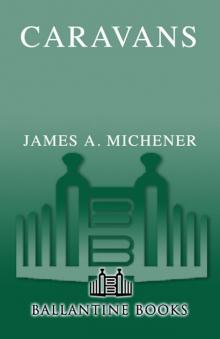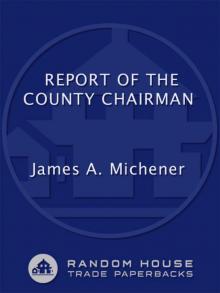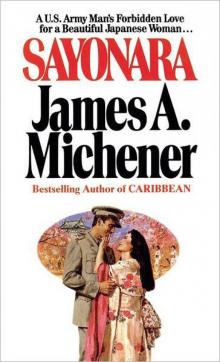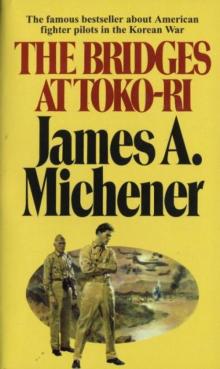- Home
- James A. Michener
Chesapeake Page 12
Chesapeake Read online
Page 12
They were two stout oval slabs of wood, fastened outboard at amidships by pivots, one to the starboard, the other to port. By convenient ropes they could be lowered into the water or lifted out, and their purpose was to counteract the normal sideways drift of a boat under sail. They were, in short, a clever, practical substitute for a fixed keel, and they worked. Like two misplaced fins of a fish, they dominated the appearance of the bateau, but Carpenter Dwight said of them approvingly, “You’ll find them valuable in the bay. Remember, when the wind is pushing you sideways on the starboard tack, put down your port leeboard. And when it pushes you from port, put down your starboard.” Steed said he thought he could manage the low, heavy bateau.
Into it he piled the goods he had collected from those unfortunates who had died during the starving time, with special attention to axes, knives, gunpowder and nails. He left Jamestown with one barrel of dried foods, an extra pair of heavy trousers and three woolen shirts. He had no medicine, no small tools, no needles for sewing, and only two knives, three forks, four spoons and a pair of guns. Yet he had not the slightest doubt that he could occupy his island, and tame it, and make it an industrious part of the empire. On June 12, 1611, he set forth, and because there was no wind, he rowed all that day down the James. His fancy leeboards were of no use, but his hands were well blistered.
However, on June 13 a tidy breeze came down the James and into it he hoisted his sail. Since the wind came from directly behind, he still had no use for his leeboards, but on the third day, as he approached the bay itself, a brisk wind swept down from the northwest, and he put his bateau on a port tack so that it would head up the bay, against the wind, and now he dropped his starboard leeboard and felt it catch the water and brace him against sideward drifting.
“Carpenter Dwight knew what he was doing!” he exulted as the wind drove him forward, and all that day he lay at ease admiring the bateau he had built.
Now the waters of the bay became familiar and he was able to tick off the rivers of the western shore—York, Rappahannock, Potomac—and when he reached the Patuxent he knew it was time to start swinging eastward to strike the entrance to the Choptank and the island he sought.
It was the longest day of the year when he approached the western end of the island, and he decided not to go ashore that night, because he could not foretell what mood the once-peaceful Choptank Indians might be in. Of one thing he was certain: he would rather be here than anywhere else in the world. This would be his empire; here he would live according to the principles of his fathers. When long-delayed night closed in, and the outlines of the island became increasingly dim, so that in the end it existed only in his mind, he uttered a prayer: “Divine Leader Who has brought me here, permit me safe conduct onto my island and allow me to live here in Thy ways.”
He could not sleep. All night he sat in his bateau staring in the direction of land, and toward four, when dawn began to brighten and his island rose from the mists like a sanctuary preserved, he shouted joyously and steered his boat around the north shore and into that safe creek he had noted three years before. As he sailed its deep clear waters and saw the massive trees lining the banks like courtiers arranged to welcome a returning king, he nodded gravely and announced, “This is the island of Devon, proprietary of the Steeds, and so it shall remain forever.”
He anchored at the head of the creek and waded ashore. After scouting the area for likely spots, he found a rise containing only a few trees, with open space enough to build a hut from which he would be able to watch the river and his boat. With the good luck that comes to countrymen who have a feeling for land, he had stumbled upon the choicest spot for building, and as the days progressed and he cleared the brush, he was satisfied that he had chosen well.
He worked from dawn till dusk, day after day, catching fish and crabs for his food and spotting the berry patches and nut trees for future use. Deer came to watch. Raccoons were plentiful and three blue herons patrolled his shore, catching so many fish that he felt certain he could do the same.
With all this food, he reflected, why did we starve in Jamestown? But as soon as he posed the question he knew the answer: Because the Virginia Indians were hostile and would not allow us to hunt or fish. And he wondered how long his muskets and bullets would defend him if the Choptank Indians turned hostile.
With so much work to do, he could not brood upon this possibility, but he did refrain from wasting ammunition. With his ax he went to the woods and began chopping down the small trees he would need for his hut, and when the outline was formed, he cut branches and wove them between the poles, as he had seen Indians do, but the result was rough and rain entered almost unimpeded. But then he brought rushes from the river and tangled them among the branches, and when he compacted them, like a woman tightening threads upon a loom, he had a satisfactory wall.
He was then free to explore his island, and found it a fascinating place. Utilizing various tricks of measurement, he calculated that it ran about two and a quarter miles east and west, one and a half north and south, for a total of something more than two thousand acres. It was cut nearly in the middle by the intruding river and a deep bay leading up from the south, and the two halves were sufficiently different to accommodate two varied styles of husbandry: sheep to the west, corn to the east. He had no premonition of what the real treasure of this land was going to be.
He had occupied his island for more than four weeks without seeing any Indians, or signs of any. No canoes had appeared on the river, nor had any fires been set. He tried to recall how far to the east he and Captain Smith had gone before they encountered the village of Patamoke, but his memory was vague.
Where can the Indians be? he thought one morning as he surveyed the empty river; he could not know they had moved eastward to escape mosquitoes.
And then toward the end of September, while he felled trees on the eastern point of the island, he saw three canoes edging gingerly out from the white cliffs opposite. They were not war canoes, so they could not have come seeking war; they seemed, in fact, timorous, for when they reached a spot about a half mile from the island they stopped. There they stayed all day, making no further gesture, even though they must have seen Steed. Finally they retired.
They repeated this for two days, and on the third Steed made signals and lured them closer, and when they were less than a hundred yards from shore, so that their faces were becoming distinct, a short thin man shouted in a language Steed could not understand. The canoes milled about, guided by what must have been conflicting suggestions, and on the spur of the moment Steed dropped his ax, walked to the edge of the water and held up his hands, empty.
The canoes moved closer, until the faces became so individualized that he could see one of the men had a cleft chin. No one spoke. Steed continued to hold his hands open and pointed to the emptiness behind him, indicating that he was alone. The Indians stared at him stolidly, remained in position for perhaps half an hour, then smartly withdrew, paddling upstream to their village.
On the fourth day this procedure was repeated, and Steed suspected that the man with the cleft chin wanted to come ashore but was restrained by the men in his canoe.
On the fifth day Steed kept about his work, watching the canoes out of the corner of his eye, but again no moves were taken by the Indians, and well before dusk they retired. He judged that on the morrow something definite would happen, and he prepared his axes and his guns. That evening, as the sun left the sky and a darkness deeper than usual enveloped the island, he recalled the scenes of torture he had witnessed, and the destructive fighting on the western shore, and he prayed: “God, let my Indians come in peace.”
He could not sleep. His hut seemed unbearably close and he left it to sit on a log, staring into the darkness and wondering what he might be forced to do in the coming day, and when the pale streaks of early dawn lighted the east he decided that he would stay in his hut, like a proper chief, and wait for the Indians to come to him. Day brightened and nothing ha
ppened. Forenoon brought buzzing insects and an inquisitive deer, but no visitors. High noon arrived, bringing with it a stillness that quieted even the rustling of the tallest trees, and then when the sun had begun its descent he saw four canoes come into his river, and in the lead position in the lead canoe sat the immensely tall Indian with the three turkey feathers, whom he and Captain Smith had met.
As the canoes approached his undefended bateau his heart beat with hammers; if the Indians wished, they could sink the boat and leave him powerless. They passed it by and came to the rock landing he had fashioned. The man with the cleft chin jumped out first, and led the way for the chief, who seemed even larger as he came on this crucial visit.
When the giant was about to reach the hut, Steed rose, extended both hands, palms up to prove that they were empty. The Indian studied them, extended his own, and looked for a place to sit. Steed beckoned him inside, and for more than an hour they talked. Neither knew a word of the other’s speech, but they spoke of deer, which were plentiful, and of oysters, which were good when dried, and of the woven wall Steed had built. The Indian considered it commendable and showed his followers that he could not penetrate its close weaving with his finger. They were unusually interested in his tools, and he showed them the axes with their sharp edges. He took down one of his guns and laboriously explained its loading and preparation. Having done this, he led the tall Indian outside and waited till some doves flew by; taking extra precautions and holding his breath so as to steady the gun, he fired. A dove fell not far from the chief, who sent the man with the cleft chin to fetch it.
“How did such a thing happen?” he asked in pantomime, and Steed explained. But remarkable as the gun was, it was the bateau that tantalized the giant chief and he asked if he might inspect it. The visit had proceeded so amicably that Steed was ready to believe that these Indians were exactly as they had been before: they were not infected by the wars of the Potomacs. So he took the tall chief to where the bateau was moored, and four of the Indians climbed aboard. They wanted to know how the sail, which lay in the bottom of the boat, operated, and what the oval leeboards were; they were perplexed by the length of the oars, but always they came back to the sail. Then began a mysterious operation, repeated many times: the chief touched the sail, then touched Steed’s face, and the Englishman could make nothing of the gestures. But finally it dawned upon him that what the Indian was comparing was the whiteness of the sail and the face.
“Yes,” Steed said. “A sail is always white.” And he hauled it up the mast and showed the Indians how to lift the anchor, and when a breeze came the boat and its five passengers moved down the creek.
Seeing their chieftain being spirited away alarmed the Indians on shore and they launched a great clatter, which the chief silenced with a gesture. He then studied the sail’s whiteness, and Steed saw that he was weeping from some deep and powerful remembrance.
When Steed was satisfied that friendly relations were possible, he indicated that he wanted to pay the tribe for the land he was occupying, so a formal procession was arranged—the bateau carrying Steed and the tall chieftain, followed by the four canoes—and it went upriver to the village of Patamoke, where the young werowance was informed of all that had occurred on the island. A deed was drawn up, dated 10 October 1611, and signed by Steed, who showed the werowance how to make his mark. The tall chief did likewise, as did the little fellow with the cleft chin. When this was completed he handed the werowance one ax, one hatchet, such cloth as he could spare and seven nails. He had traded a fair portion of his worldly wealth for an island the Indians not only did not need, but had never used.
And when the paper was folded, and the long clay pipes were smoked, he did more. By sign language he promised them that when trade was established he would give them additional gifts, and he insisted upon this because the pact had brought him slightly more than four thousand acres, half on the island, half on the facing shore, and some of it the choicest land along the river. By this treaty, his immediate problems of existence were also relieved, for he received an unlimited supply of vegetables, and he could sleep at night untroubled.
But what galvanized his imagination was something he saw as he was about to leave: in the corner of the long house lay a bundle of beaver pelts, and when he asked where they had come from, the werowance pointed generally to the south, indicating that in the marshy lands across the river there was an endless supply of beaver.
Then Steed knew what he must do: he must convince the Indians to bring him many pelts against future trading privileges; he would deliver the furs to Jamestown, where ships from England would barter for them. The result would be a constant flow of axes, cloth, guns and nails, with a generous profit to him on all transactions. His ancestors in England, dating back to the thirteenth century, would have been mortified to think that Steed was about to engage in trade—that was forbidden a gentleman—but Edmund rationalized that none of them had tried to settle virgin acreage. He would make himself the best trader in the colony.
But like Captain Smith on the banks of the York, he failed to spot the commodity which would form the true basis of his wealth. As he stowed the beaver pelts in his bateau he did not notice that in an opposite corner of the long house the werowance had another treasure, a pile of the best tobacco leaves. The English gentlemen who emigrated to the New World did not learn rapidly; they were amazingly delinquent in acquiring the skills that mattered, like fertilizing corn with dead fish or living off oysters when meat was unavailable, but when they did finally learn something, they clung to it desperately and made it better: Edmund Steed had learned how to accumulate beaver pelts.
But there was one question the Choptanks did not answer for him, the one that would perplex every European settlement in the New World: where would the men who fought the wilderness find women? Each nation solved this vital problem according to its traditions. In Canada the French forerunners were already taking Indian brides. In Mexico to the south, where a flourishing civilization had developed, Spaniards had adopted two solutions: some married Aztecs, some sent home for childhood acquaintances. In Brazil the Portuguese, finding jungle Indians incompatible, chose black women who had been imported as slaves from Africa. And in Virginia the stiff-lipped Englishmen did nothing until such time as shiploads of properly assembled London women could be delivered by artful ships’ captains, who sold the ladies off for payment of their passage money, plus an undisclosed profit.
Edmund Steed, now thirty-two, would never have thought of taking into his hut an Indian girl. An English gentleman married an English gentlewoman, preferably of one’s own country and religion, and if none came along, the gentleman might wait till he was thirty-five or even forty. Steed thought that when he delivered his beaver pelts to Jamestown it would be about time to consider buying a bride, but until then he was content to live alone.
Not really content, not really alone. The tall chief, having observed his loneliness, waited for a day when he and Steed bargained in broken words for a pile of pelts, and when a trade was concluded and the lesser Indians had left, he uttered a low call. From behind reeds at the end of the wigwam a seventeen-year-old girl appeared, wearing soft brown deerskin and cockleshells in her hair. Steed recognized her as the child he had seen on that first trip to the Choptank, and he even recalled her name, Tciblento, although at their first meeting he had misspelled it.
“She is to accompany you to the island,” the white-haired chief said. “She has been saved for this moment.”
The beautiful girl kept her gaze downcast and would not look at her father’s guest, but her eagerness to visit the island was apparent. Steed blushed and rejected the offer with prolonged attention to protocol: he was honored; she was lovely; the chief’s friendship meant everything. And something in the way he spoke conveyed to the waiting girl the fact that he was rejecting her, and her slim shoulders drooped like the petals of a flower left in the sun.
Her father would not accept this decision; in agitat
ed words he explained that his two sons were married to Choptank maidens, but that he had always hoped Tciblento might mate with a Susquehannock worthy of her. But this had not happened. He ended with his eyes close to Steed’s, pleading with him to accept this child, and when the Oxford man indicated by manner, if not by words, that never could he marry an Indian, the old man said, “I bided my time and trusted that when the Great Canoe came ...”
“What is the Great Canoe?” Steed asked.
“It came a long time ago, and we knew it would return. We waited.” He formed a sail with his fingers.
“You mean our ship?”
“Yes, we knew you were coming.” He would say no more, but he did persist in the matter of his daughter. “She is a good girl. She cooks, traps beaver, knows where the oysters and crabs are.”
Steed was embarrassed. For a chief to be peddling his daughter was undignified, and for an Englishman to accept would be repugnant. Firmly he said, “No. She cannot come.” The girl did not weep or run away; she stared at Steed with her great dark eyes as if to say, “Sir, what an error you make.”
Pentaquod, his self-respect shattered by what was happening, felt that he must show the Englishman the character of a Susquehannock warrior. Summoning the man with the cleft chin, he ordered him to designate two Choptank men to accompany Steed back to the island and there to make their homes, helping him in all things. Each of the men brought a woman and built a wigwam, so that Devon was properly settled.
But this was no solution for Steed—he still lacked a wife, and when the time approached in 1614 for him to load his bateau with beaver pelts and return to Jamestown, he felt a growing sense of excitement. He thought: One of the ships coming to trade would surely bring a cargo of women. Perhaps he would find one whose passage money he could pay. But a moment’s reflection warned him that if any women had arrived, they would have been picked off by the local settlers; his chances of finding a wife would not be good. He therefore drafted a letter to his father, not even knowing if Sir Fairleigh was still alive:

 Mexico
Mexico The World Is My Home: A Memoir
The World Is My Home: A Memoir Sayonara
Sayonara Chesapeake
Chesapeake The Novel
The Novel Rascals in Paradise
Rascals in Paradise Return to Paradise
Return to Paradise Presidential Lottery: The Reckless Gamble in Our Electoral System
Presidential Lottery: The Reckless Gamble in Our Electoral System The Source
The Source Poland
Poland Space
Space Caravans
Caravans Creatures of the Kingdom: Stories of Animals and Nature
Creatures of the Kingdom: Stories of Animals and Nature Iberia
Iberia Hawaii
Hawaii The Watermen: Selections From Chesapeake
The Watermen: Selections From Chesapeake Report of the County Chairman
Report of the County Chairman The Covenant
The Covenant The Bridges at Toko-ri
The Bridges at Toko-ri Matecumbe
Matecumbe Journey: A Novel
Journey: A Novel Centennial
Centennial Sports in America
Sports in America Texas
Texas Miracle in Seville
Miracle in Seville This Noble Land: My Vision for America
This Noble Land: My Vision for America Tales of the South Pacific
Tales of the South Pacific Bridges at Toko-Ri
Bridges at Toko-Ri Space: A Novel
Space: A Novel Presidential Lottery
Presidential Lottery Sayonara: A Novel
Sayonara: A Novel This Noble Land
This Noble Land The Covenant: A Novel
The Covenant: A Novel Miracle in Seville: A Novel
Miracle in Seville: A Novel The Bridge at Andau
The Bridge at Andau Source
Source The Source: A Novel
The Source: A Novel Journey
Journey Recessional: A Novel
Recessional: A Novel Legacy: A Novel
Legacy: A Novel The Bridges at Toko-Ri: A Novel
The Bridges at Toko-Ri: A Novel Poland: A Novel
Poland: A Novel